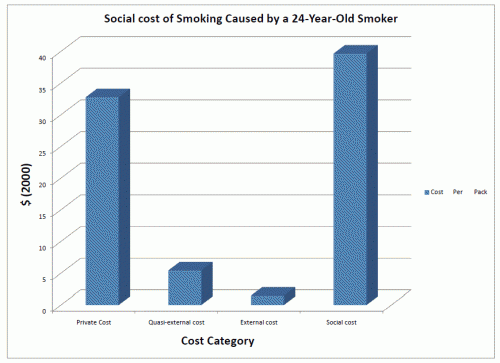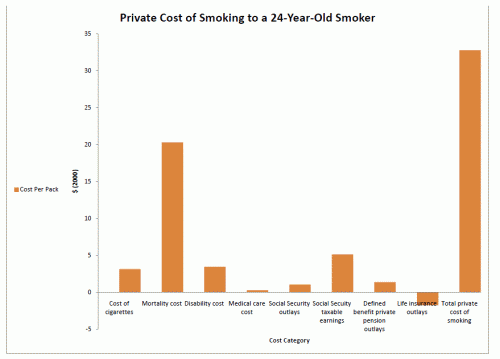Yesterday’s post provided an overview of the cost of smoking, and estimated that the social cost of smoking is around $40 per pack (in 2000 dollars). The graph below shows the relative magnitude of private, quasi-external (family), and external costs, which together equal the social cost. All costs are displayed in dollars per pack of cigarettes smoked, but the book (The Price of Smoking, MIT Press, 2004) I wrote with colleagues provides detailed estimates by gender and cost category, as well as national aggregate cost estimates.
 This post focuses on the private cost of smoking which we estimate to be around $33 dollars per pack, or approximately 80% of the social cost. Private costs–those costs due to smoking that are borne by smokers themselves–are by far the largest component of the social cost of smoking. We estimated costs using a life cycle approach that compared costs for 24 year old smokers to those of non smokers and attributed the differences to smoking (with some adjustments). Our method accounted for smoking cessation patterns and their influence on the social cost of smoking. All of the relationships estimated were based on large amounts of (mostly) longitudinal data. The methods will be described in a later methodological post.
This post focuses on the private cost of smoking which we estimate to be around $33 dollars per pack, or approximately 80% of the social cost. Private costs–those costs due to smoking that are borne by smokers themselves–are by far the largest component of the social cost of smoking. We estimated costs using a life cycle approach that compared costs for 24 year old smokers to those of non smokers and attributed the differences to smoking (with some adjustments). Our method accounted for smoking cessation patterns and their influence on the social cost of smoking. All of the relationships estimated were based on large amounts of (mostly) longitudinal data. The methods will be described in a later methodological post.
By far the largest component of the private cost of smoking is mortality cost ($20.28/pack). This is our estimate of the value of life lost due to smoking, which can be viewed as a willingness to pay estimate. We used a conservative estimate of $100,000/life year lost, even though many life saving interventions that cost more than $100,000 per life year saved are in widespread use. The next largest component of private costs is lost wages due to smoking ($5.10/pack), estimated by lost Social Security-taxable earnings, which is likely an underestimate since it understates lost income for persons with wages above the Social Security payroll tax maximum. Note that this is not double counting; the mortality/willingness to pay estimate represents the consumption value of a lost life year in economic terms, which is viewed as independent of wages. In non-economic language, it could be viewed as the inherent value of being alive, which is again separate from income. Note that the lost Social Security wages per pack estimate is weighted by gender which obscures extreme gender differences in lost wages due to smoking ($38,566 for males, $631 for females). This is due to both mortality and wage differences by gender that are related to smoking.
We estimated the cost of disability due to smoking at $3.44/pack, and increases in out of pocket medical costs were relatively small at $0.24/pack. Smokers receive less in both private pensions ($1.36/pack) as well as in Social Security outlays ($1.01/pack). A curious finding of our work is that non-smokers cross subsidize smokers in private life insurance markets. While smokers pay higher premiums, they do not pay increased premiums sufficient to account for their excess mortality compared to non smokers, so we credited smokers with a $1.78/pack subsidy that is shown in the chart below by the only bar that sticks down instead of up.
The cost of cigarettes was estimated at $3.12/pack* in 2000 dollars, likely an understatement of the true cost since in our estimates the real price of cigarettes did not rise over time. However, they have risen since we did this work and may continue to do so. There were some private costs that were identified in past literature that we excluded due to having limited data, such as extra costs of dry cleaning and house cleaning for smokers that have been estimated to be in the range of $300-500 per year.
The figure below shows the distribution of the private cost of smoking.
The present value of the private cost of smoking to a 24 year old smoker in 2000 was $141,181 ($182,860 for men, and $86,236 for women) per smoker. The national or aggregate cost that each cohort of 24 year old smokers impose upon themselves over the course of their life is estimated to be $168 Billion (all in 2000 dollars). This is a large number, but it is important to remember that these costs are spread across 5 or 6 decades for some of these smokers. Several points bear highlighting:
- Some would say private costs resulting from private decisions require no public policy response, so long as excise taxes are set at an appropriate amount to cover external costs. The large amount of smoking cessation and regulation efforts undertaken show that is not the predominant perspective held in society. There are many policy efforts undertaken to prevent smoking and encourage cessation.
- Our estimates of the private cost of smoking suggest that individuals must receive at least $141,181 worth of benefit from smoking over the course of their life (from age 24 until death or they stop smoking) if smoking is a rational decision. We have not attempted to measure the benefits of smoking, but if one were assuming forward looking consumers, who have perfect information on costs and benefits, and who have stable preferences, the benefits of smoking would have to be very large. An alternative explanation is that smokers are irrational. Of course the addictive nature of cigarettes complicates this analysis and there is ample reason to believe costs and benefits are not well understood at young ages when most people start. These issues help explain why most reject that smoking is a pure private activity, even if tax rates could cover the external costs.
- Smoking is an activity that has become taboo, and in some circles is viewed as truly irrational, or even unimaginable. Yet some persons continue to smoke. It is worth remembering that there are many activities that are commonly engaged in that are viewed as unwise by some. Just to give an example, detailed sub-calculations in our book (see box 11.1 on p.248) show that an average smoker smoking 400 packs per year gives up around 800 hours of future life expectancy by doing so. By comparison, between one-sixth and one-third of adults watch at least 2 hours of television per day. Leaving aside multi-tasking, and making the assumption that watching television is non-productive, this time could be understood as ‘lost’ in much the same way life span is lost to smoking. Television watchers may say they enjoy watching TV, but so to will smokers likely say they enjoy smoking. The point is, any activity that consumes around 2 hours per day in a manner that is judged to be ‘wasted’ or ‘lost’ could be estimated to have a private cost similar to that of smoking. A mix of market incentives (higher taxes, others) and detailed understanding of the psychology of smoking are likely needed to further reduce smoking incidence and prevalence.
- The extra medical cost borne by smokers is relatively small ($0.24/pack) compared to other private costs. There are currently a variety of policy initiatives related to further increasing either the out of pocket cost for medical care for smokers, or the premiums they pay. Whether this is a good idea turns out to be a complicated question, because it depends upon the goal of the policy. You also must move out of the realm of purely private costs of smoking and begin to look at the external costs.
Tomorrow’s post will start to do this by focusing on the quasi-external costs of smoking that are imposed upon the families of smokers.
Full citation: Frank A. Sloan, Jan Ostermann, Gabriel Picone, Christopher Conover and Donald H. Taylor, Jr. The Price of Smoking. MIT Press: 2004. The Price of Smoking is available as an ebook.
*We estimated the price of a pack of cigarettes as follows. We took lifetime cigarette excise tax payments based on age-specific consumption from the 1998 National Health Interview Survey (NHIS), discounted by 3% per year, multiplied by the probability of survival to each year for a typical 24 year old smoker, and multiplied this estimate by the average price-to-tax ratio in the year 2000.
update: cleaned up a few places

